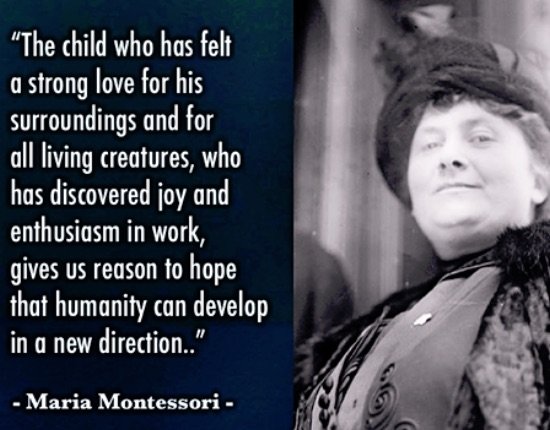Montessori Education
Dr. Maria Montessori 1870-1952
 Dr. Montessori was the first female graduate in medicine from the University of Rome, Italy. It was through observation and working with institutionalized children that she developed this teaching method. The disturbed and handicapped children progressed very rapidly beyond even the average child. Montessori proved to the world that it is not necessary to keep special needs children from the general population and raised the question: What are we doing wrong with normal children that they can be outperformed by the mentally retarded?
Dr. Montessori was the first female graduate in medicine from the University of Rome, Italy. It was through observation and working with institutionalized children that she developed this teaching method. The disturbed and handicapped children progressed very rapidly beyond even the average child. Montessori proved to the world that it is not necessary to keep special needs children from the general population and raised the question: What are we doing wrong with normal children that they can be outperformed by the mentally retarded?
The first American Montessori School was founded in the United States in 1911. In 1960 The American Montessori Society was founded. The efficient and accelerated learning achieved by Montessori’s approach caught the attention of middle class Americans. Montessori’s ideas continue to stimulate today a holistic tradition and approach to education. Empirical research reaffirms her observations that the child unfolds in definite stages.
Educational goals require approaches that honor a global, ecological, and spiritual worldview. Holistic education is an approach whose time has come. We are approaching a crucial point in history. We must soon choose between total destruction of the ecosystem, or a new worldview that strives for peace, cooperation, and justice based upon a reverence for life. The world is in agony now and it is almost hard to believe it can be saved. It takes a shift of consciousness. It takes reverence for all of life.
Only through inner discipline can one become truly free to learn. When he has mastered learning techniques and materials he is free to be creative. Only when he understands reality, can be truly imaginative.
Dr. Maria Montessori’s Educational Principles
1. The child is in a constant state of growth and change. The way a child grows and changes, may be modified by the environment.
2. A young child wants to learn and needs encouragement and opportunities for learning that permit him to learn with others and by himself.
3. The mind of the young child has great capacity for absorbing a large variety of experience, though he can’t express it verbally. From birth to age six is the time when intelligence is being formed.
4. To foster learning the environment should be prepared so that a child can choose the learning activities he is ready for.
5. A child learns through movement which should not be restricted any more than is necessary for his safety and to avoid interference with the rights of others. He needs opportunities to move about, explore, and learn through every sense organ of the body.
6. Children go through specific stages of development when it is easier to acquire certain types of learning. Children go through periods of intense and extraordinary interests in certain aspects of their environment to the exclusion of others. They pass through definite sensitive periods in which they reveal psychic aptitudes and possibilities that later disappear.
7. Sensory motor exercises play a great role in a child’s learning. The more opportunities a child has to feed sensory stimuli into his growing brain, the more his intelligence will develop.
8. Children learn best in atmospheres of freedom combined with self-discipline in an environment to help them learn.
9. The teacher should not impose learning on a child or intrude on what a child is learning by himself.
10. The child should be able to learn at his own pace and level of readiness.
11. A child develops a sense of his own worth by doing any simple task well. He needs great opportunity for successes.
12. When a child is given a chance to learn, he increases his intelligence and gains contentment, satisfaction, self-confidence, and a desire for further learning.
Dr. Montessori was the first female graduate in medicine from the University of Rome, Italy. It was through observation and working with institutionalized children that she developed this teaching method. The disturbed and handicapped children progressed very rapidly beyond even the average child. Montessori proved to the world that it is not necessary to keep special needs children from the general population and raised the question: What are we doing wrong with normal children that they can be outperformed by the mentally retarded?
